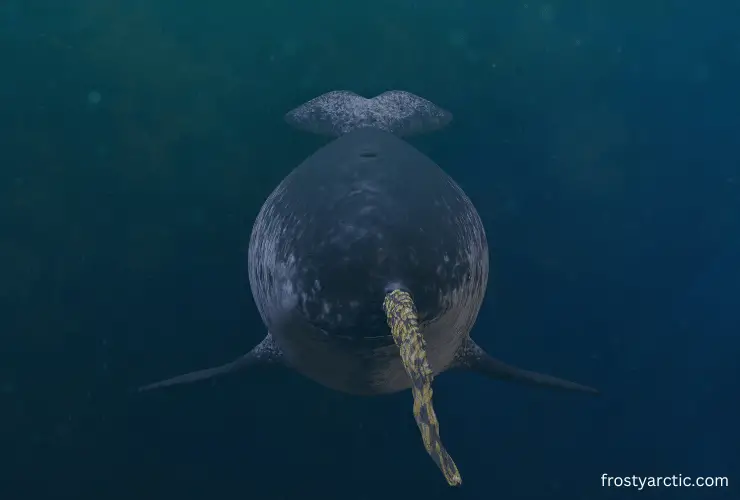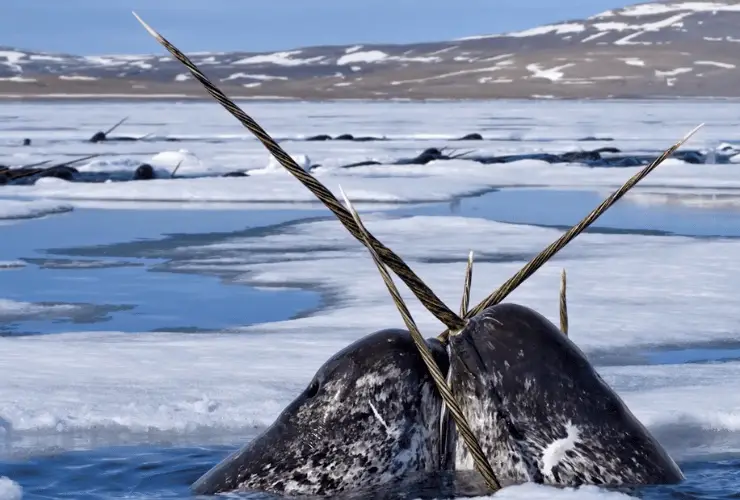A narwhal tusk is a long, spiral-shaped tooth that grows from the upper jaw of male narwhals (Monodon monoceros). Narwhals are known for their distinctive appearance; the tusk is perhaps their most iconic feature. The male narwhal grows a single long tusk or tooth reaching up to 10 feet long.
A narwhal tusk sounds like something out of a fantasy novel, but it’s actually real. These tusks come from the narwhal whale, which lives in the Arctic waters.
Despite their long history and unique appearance, narwhal tusks are still somewhat of a mystery. So let’s dive into the topic and explore all the fascinating truths about narwhal tusk and teeth!
What are Narwhals’ Tusks?

The narwhal’s tusk is a remarkable feature distinguishing it from other marine mammals. Male narwhals have two elongated tusks in their upper jaw that grow forward, not downward, like teeth in other species.
The tusk is a defining characteristic of the narwhal species, and its unique shape even inspired its scientific name, “Monodon monoceros.”
Occasionally, some males may also have a shorter tusk on the right side, and rare instances of abnormal tusk growth have been observed in the lower jaw.
At What Age Do They Get This Tusk? Do They Have Tusk from Their Birth?
Narwhals are not born with tusks. Instead, the tusk progressively grows after birth, typically starting to develop around the age of 9 months. It continues to grow throughout the narwhal’s life, eventually reaching lengths of 8-10 feet.
It’s crucial to note that not all male narwhals will grow tusks. In contrast, female narwhals usually don’t have tusks and don’t develop them as they age.
Narwhal’s Tusk: Let’s Discuss in Detail
About Narwhals’ Tusk and Its purpose
The narwhal’s tusk isn’t for fighting or skewering. It’s filled with nerves, acting as a sensory organ. Some narwhals stun small fish briefly, but they aren’t highly dangerous. Their tusks are fascinating, not menacing. It’s yet another example of the wonders found in the animal kingdom!
A recent study has shed light on the genuine evolutionary function of narwhals’ impressive 9-foot-long tusks, revealing a connection to their mating behavior. The research indicates that male narwhals employ these tusks to compete for and allure potential mates, much like a peacock’s ostentatious feathers or an elk’s elaborate antlers.
Lengths of narwhal tusks

How Long is the Narwhal Tusk? The lengths of narwhal tusks can vary among individuals. But on average, it ranges from about 1.5 to 3 metres (5 to 10 feet). Some narwhals have shorter tusks and others have longer tusks.
Did you know how Long is the Largest Narwhal Tusk? The largest narwhal tusk is about 10 feet long. The narwhal’s tusk grows throughout its life, eventually reaching an impressive length.
Purpose of a Narwhal Tusk
So, what is the True Purpose of a Narwhal Tusk? The true purpose of a narwhal tusk has been a subject of scientific speculation and study. It was originally believed that the tusk was used for hunting or breaking ice to create breathing holes.
However, more recent research suggests that the tusk is more likely involved in behaviors related to communication and social interactions that determine hierarchy and attracting mates. It is also believed that the tusk’s sensitivity to environmental changes helps narwhals navigate and locate food.
Are there Any Narwhals Without Tusks?
Yes, there are narwhals without tusks. Usually, female narwhals are without tusks. In contrast, male narwhals develop the long, spiral tusks that they are famous for. But not all males grow them. Some male narwhals have small tusks that don’t fully develop, and a small percentage of males may not have tusks at all.
On the other hand, female narwhals rarely grow tusks. But if they do, they are usually much smaller and less prominent than those of the males. The exact reasons for the variability in tusk growth among narwhals have yet to be fully understood.
The Anatomy of Narwhal Tusk: Is the Narwhal Tusk Rigid (hard) or Flexible?

The narwhal tusk is rigid and hard. It is composed of a special type of elongated tooth that grows through the upper jaw of male narwhals. This unique tooth is actually an elongated, spiral-shaped incisor. Unlike most other teeth in mammals, which are embedded in the jawbone, the narwhal tusk grows forward from the upper jaw, extending out of the narwhal’s head.
The tusk is made of dentin, a dense and hard material similar to what forms human teeth. Surrounding the dentin is a thin layer of enamel, the hardest substance in mammals. The dentin and enamel give the narwhal tusk its characteristic strength and rigidity.
Although the tusk appears solid, it does have a small number of sensory nerve endings running through it. These nerves help the narwhal sense temperature, pressure, or salinity changes in the water around them.
Are Narwhal Tusks Dangerous and Poisonous?
No, narwhal tusks are not dangerous and poisonous. Despite their formidable appearance, narwhal tusks are not used as weapons or for aggressive purposes. Narwhals are generally gentle and elusive creatures.
Instead, the tusks are believed to serve several important functions related to their survival and behavior. Further. It’s important to note that these tusks are not poisonous at all. They do not contain any toxic substances or venom.
What Other Sea Animals Have Tusks?
These are some of the notable sea animals that have tusks other than narwhals:
- Walrus (Odobenus rosmarus)
- Elephant Seal (Mirounga)
- Babirusa (Babyrousa)
- Beaked Whales (Ziphiidae family)
What if the Narwhal Tusk Breaks?
If a narwhal’s tusk breaks, it can’t grow back. Unlike other animals, narwhals cannot regrow their tusks once broken. The tusk is a specialized elongated tooth unique to each individual narwhal, and once it is broken, it remains in its altered state.
Since the tusk is a living part of the narwhal, breaking it can be a traumatic event for the narwhale. It can affect the narwhal’s ability to perform certain behaviors, such as mating displays, which are important for social interactions and breeding.

FAQs
Do Narwhals Have Teeth?
No, narwhals don’t have traditional teeth in their mouths. Instead, their most prominent tooth is their tusk. It is believed that their unique tusk is their tooth. Other than this, they don’t contain any teeth.
How Many Teeth Does a Narwhal Have?
As mentioned above, it doesn’t contain any teeth in its mouth. Their tusks are considered teeth. So, they usually have 2 tusks which means 2 teeth.
What Makes a Narwhal Tusk Have Teeth?
The researchers concluded that the narwhal’s tusk is a canine tooth rather than an incisor. It is based on its origin in the maxillary bone, where canine teeth typically emerge in mammals.
This study represents the first confirmation of the tusk’s identity as a canine tooth. In most mammals, canines are positioned vertically in the mouth and serve purposes such as gripping and holding food or functioning as weapons.
How Do Narwhals Eat? Do they use Tusks or Teeth while Eating?
Narwhals eat through a suction process. They swallow their whole prey and don’t use their tusks or teeth while eating. Instead, they are adapted to efficiently capture and consume their prey using their specialized mouth and throat structure. But sometimes, they use their tusks to prey.
Are narwhal tusks sold for any purpose?
Yes, narwhal tusks have been historically sold for various purposes. The tusks are unique and captivating, making them desirable as collectible items, decorative pieces, and status symbols.
In the past, narwhal tusks were sometimes called “unicorn horns” and were believed to have mystical or magical properties. They surpassed even the price of gold by far. It was believed that merely touching a drink with a unicorn tusk could neutralize any poison it contained. So, rich people used it in crockery.
Conclusion
The narwhal tusk remains an enigmatic marvel of nature, captivating human imagination for centuries. Far from being just a weapon, this long, spiral tooth serves many vital functions for these majestic Arctic whales.
While some mysteries still surround the true purpose of the tusk, recent research indicates its involvement in communication, social interactions, and navigating the environment. As we explore the depths of our oceans, the narwhal’s tusk reminds us of the vast wonders that nature conceals.


